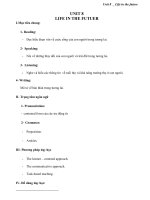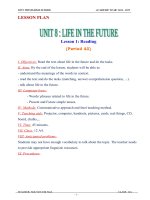- Trang chủ >>
- THPT Quốc Gia >>
- Hóa
Life in the bay
Bạn đang xem bản rút gọn của tài liệu. Xem và tải ngay bản đầy đủ của tài liệu tại đây (3.19 MB, 12 trang )
Life
in the
by Lisa Oram
Genre
Nonfiction
Comprehension Skill
Predict
Text Features
• Captions
• Labels
• Glossary
Science Content
Food Chains
Scott Foresman Science 1.5
ISBN 0-328-23486-9
ì<(sk$m)=cdeigi< +^-Ä-U-Ä-U
Life Sciences
Bay
Vocabulary
Extended Vocabulary
food chain
marsh
shelter
endangered
habitat
tides
wetland
by Lisa Oram
Picture Credits
Every effort has been made to secure permission and provide appropriate credit for photographic material. The
publisher deeply regrets any omission and pledges to correct errors called to its attention in subsequent editions.
Unless otherwise acknowledged, all photographs are the copyright of Dorling Kindersley, a division of Pearson.
Photo locators denoted as follows: Top (T), Center (C), Bottom (B), Left (L), Right (R), Background (Bkgd).
Opener: Amos Zezmer/Omni Photo Communications; 2 (B) Fred Bavendam/Peter Arnold, Inc.; 3 (T) Frans Lanting/
Minden Pictures; 4 (B) Hoberman Collection/Getty Images; 6 Amos Zezmer/Omni Photo Communications; 7 (B) Karen
Hunt/Corbis; 8 (L) Tom & Pat Leeson/Photo Researchers, Inc., (BR) Daniel W. Gotshall/Visuals Unlimited; 9 © Andrew
Syred/Photo Researchers, Inc.; 10 Richard R. Hansen/Photo Researchers, Inc.; 11 Lockwood, C.C./Animals Animals/Earth
Scenes; 12 (TL) David Weintraub/Stock Boston, (BR) Luce, Willard/Animals Animals/Earth Scenes; 13 Richard Herrmann/
Visuals Unlimited; 15 Gerald & Buff Corsi/Visuals Unlimited; 16 Corbis; 17 Jeff Greenberg/©Jeff Greenberg.
ISBN: 0-328-23486-9
Copyright © Pearson Education, Inc. All Rights Reserved. Printed in the United States of America.
This publication is protected by Copyright, and permission should be obtained from the publisher prior to any
prohibited reproduction, storage in a retrieval system, or transmission in any form by any means, electronic,
mechanical, photocopying, recording, or likewise. For information regarding permission(s), write to
Permissions Department, Scott Foresman, 1900 East Lake Avenue, Glenview, Illinois 60025.
1 2 3 4 5 6 7 8 9 10 V010 13 12 11 10 09 08 07 06
What You Already Know
Animals and plants need each other to
live. Animals use plants and other animals for
shelter. Some animals use plants to make nests.
Some animals live on other animals. Animals
use plants or other animals for food. Animals
help plants spread their seeds.
Plants and animals depend on each other
through food chains. Plants take in light from
the Sun to grow. Animals eat plants and other
animals. Animals that eat animals have sharp,
pointed teeth. Animals that eat plants have flat
teeth.
A caterpillar eats a leaf. A bird eats the
caterpillar. The leaf, the caterpillar, and the bird
are part of a food chain. There are different
food chains in deserts and marshes.
In this book, you will read about animals
and plants that live in the San Francisco Bay.
2
3
San Francisco Bay
Water is important in California. The Pacific
Ocean borders the whole state. There are many
rivers and lakes in California.
The San Francisco Bay is a body of water in
California. The Bay connects the Sacramento
River and the San Joaquin River to the Pacific
Ocean.
Many people live around the Bay. Plants and
animals live in the Bay too.
The Suisun Marsh is in the Bay. It is the
largest wetland in California. A wetland is an
area of land that has a lot of water in the soil.
Suisun Marsh
San Francisco Bay
4
5
Oceans have salt water. Rivers have fresh
water. The Bay is a mixture of salt water and
fresh water. The saltiness of the Bay water
changes.
Tides are the rise and fall of the ocean. At
high tide, the Bay fills with ocean water. At low
tide, the Bay has less salty water. There is more
fresh water from the river.
Weather also changes the saltiness of the
Bay. Rain brings fresh water to the Bay. When
snow melts in the mountains, more fresh water
reaches the Bay.
The amount of fresh water changes with the
seasons. In summer it is dry. There is less fresh
water and more salt water in the Bay. In winter
it is wet. There is more fresh water and less salt
water in the Bay.
Ocean tides change
the Bay.
Rain brings water to
the Bay.
6
7
Animals in the Bay
The Bay is a special place for animals to live.
Many different animals live there.
Some animals live on the muddy bottom of
the Bay. Living things attach to the shells of
decorator crabs. They hide the crabs from fish
that might eat them.
There are lots of fish in the Bay. Salmon live
in the ocean most of their lives. But they lay
their eggs in fresh water. Some salmon swim
through the Bay to the rivers.
Delta smelt also live in the Bay. They eat
zooplankton. Zooplankton are tiny animals.
They are too small to see with your eyes.
Zooplankton
Salmon
Decorator crab
8
9
Birdwatchers love the San Francisco Bay.
Thousands of birds live and feed there.
Swans, ducks, and geese use the Bay for food
and shelter. Some birds find food in the shallow
waters. They eat small fish and animals. The
brown pelican flies above deeper water. It dives
for food from the air.
Seals and sea lions live in the Bay. Harbor
seals live mostly in the north and south parts of
the Bay. You might see baby seals in the spring!
Harbor seals don’t like noise or people. If you
see them on an island, stay away. Sea lions sit
on the rocks near Pier
39. They don’t seem to
mind the busy city.
A brown pelican lands
in the Bay.
Sea lions like to lie on
the pier.
10
11
Plants in the Bay
Many different plants live in the San
Francisco Bay. Cattails in the marsh can be six
feet tall. California poppies grow in dry parts of
the marsh.
Algae are tiny plants that float in the water.
It’s the most common plant in the Bay. The
food chain starts with algae.
Eelgrass lives covered by water. It grows in
underwater fields. Eelgrass grows quickly. It has
flowers. Leaves fall off into the mud. The leaves
make the mud better for other animals and
plants.
Young fish make their home in eelgrass.
Snails eat the leaves.
Eelgrass
Algae
Cattails
12
13
Pickleweed grows close to the ground.
Sometimes tides cover it.
Pickleweed can grow very thick. It can also
live in salty water. It has flowers that bloom in
spring and summer.
Some animals also live in pickleweed. They
can hide from hawks in the branches.
In summer, there might be orange strings
on the pickleweed. The strings are another
plant called saltmarsh dodder. The thin strings
dig their roots into the pickleweed. Soon the
pickleweed roots will die.
Saltmarsh
dodder
Pickleweed
14
15
People and the Bay
San Francisco is a big city. Many people live
around the Bay. They ride boats and go fishing
in the Bay. People use water from the Bay.
They build dams to hold back the water. Big
pumps take water from the Bay for drinking.
Farmers use water that goes into the Bay for
their fields.
People change the habitat, or natural place,
where animals and plants live. Animals and
plants can be hurt by changes in their habitat.
This dam is on a river that
goes into the Bay.
Water from the Bay helps
generate electricity.
16
17
The salt marsh harvest mouse lives in the
San Francisco Bay. It is endangered. This
means it could die out. There aren’t many of
them around.
At high tide the mice hide in bushy plants
like pickleweed. There are not enough plants to
protect them.
The mice need salty water to live. Cities
around the Bay put extra fresh water into the
Bay. This hurts the mice.
Scientists study the Bay. They count the
plants. They watch where the animals move.
People make plans to keep the Bay healthy.
People, plants, and animals all need the San
Francisco Bay.
Salt marsh harvest
mouse
18
19
Glossary
What did you learn?
1. How do animals in the Bay use eelgrass?
endangered in danger of dying out
2. Where do some salmon lay their eggs?
habitat
a place where a plant or
animal lives
3.
tides
the rise and fall of the ocean
You just learned
about the San Francisco Bay. Write a short
story about a body of water near your
home or one you have visited. What kinds
of plants and animals live there?
wetland
a place that is covered by
water at least part of the year
4.
Predict Look at the story of the mouse
on page 18. What might happen to the
mouse?
20









